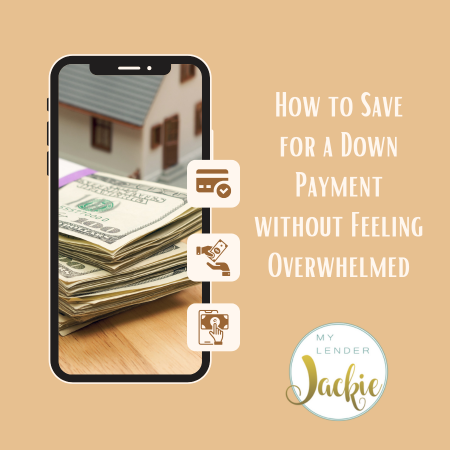If buying a home is your dream, but the thought of saving a down payment is totally daunting, then you are in the right place. We know that saving up to buy a home might be an overwhelming thought—especially when you hear the common misconception that you need 20% down to buy a home. The good news? You don’t always need to save 20%, and there are ways to break the process into manageable steps so that saving for a down payment doesn’t feel overwhelming. Here’s how to make it happen.
Step One: Know How Much You Really Need

For example:
- Conventional Loans: You may be able to put down as little as 3-5%.
- FHA Loans: Require as little as 3.5%.
- VA and USDA Loans: Sometimes allow for zero down payment if you qualify.
Start by researching what’s realistic for your situation and the type of home you want. This way, you can set a clear, achievable savings goal. Aiming for 5% of the purchase price of a potential home is a great place to begin.
Step Two: Set Up a Dedicated Savings Account
Opening a separate savings account specifically for your down payment can help you track your progress and keep the funds out of reach for everyday expenses. Look for a high-yield savings account to earn a bit of interest on your savings.
Automating your savings by setting up direct deposits from your paycheck can also make the process feel effortless. Even small, consistent contributions can add up over time. By setting up a separate account, you can stay motivated as you watch this account balance grow with a specific target in mind.
Step Three: Find Places to Trim in Your Budget
While you’re saving up, it’s a good idea to take a close look at your budget and look for places you’re willing to trim, even if it’s only temporary. Take a close look at your spending and see where you can cut back. You don’t need to overhaul your lifestyle; even small changes can make a big difference.
These are some ideas:
- Dining Out: Reduce the number of times you eat out each month and put the saved money into your down payment fund.
- Subscriptions: Cancel unused or underused subscriptions.
- Impulse Purchases: Pause before making unplanned purchases and ask yourself if that money could go toward your goal instead. Some people find it helpful to have a 24 hour rule. Rather than making an impulse buy, they have to wait 24 hours to make sure they actually want to spend the money.
Use budgeting apps to help track your spending and identify areas for improvement.
Step Four: Stay Focused on Your Why
Saving for a home often requires sacrifice, so it’s essential to stay focused on why you’re doing it. Saving can feel like a grind, but keeping your end goal in mind helps you stay committed. Visualize your future home and the life you want to build there. Remind yourself why this goal is important to you, whether it’s creating stability for your family, having a space to call your own, or investing in your future.
Step Five: Work with the Right Mortgage Team
Partnering with an experienced mortgage lender like us will help you navigate the process and explore your options. We can provide insights into what’s realistic for your situation and guide you through programs that fit your financial profile. In fact, we’ve become experts at creative solutions for buyers who originally thought they couldn’t qualify at all.
If you want to apply for a mortgage or talk with a loan officer to learn more about the process, just contact us any time. We want to help you reach your goals, whether you are ready to buy now or just have some questions.

